Contact lens technology is advancing to incorporate a wide range of components that enable functions from measuring blood sugar and intraocular pressure, to the delivery of pharmaceuticals. Currently in development are lenses that contain nano-structures and miniaturized electronics and optics that provide hands-free visual content. In the near future, the regulatory process will be presented with new categories of contact lenses and, following market clearance, practitioners will have the opportunity to prescribe lenses for new indications.
Vernor Vinge, Ph.D., former professor of mathematics at San Diego State University and a futurist science fiction writer, wrote of contact lens wearable computers several years ago in his novel, “Rainbows End.” Just as Jules Verne accurately foresaw submarine technology decades in advance of the final execution, Dr. Vinge foresaw contact lenses as the console for anytime and anywhere wearable and interactive information access.
Smart Lenses as Medical Indicators
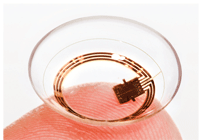
1. Sensimed smart lenses measure IOP.
A team at the University of Maryland has developed a patented technology for monitoring blood glucose with contact lenses that change color as a function of blood sugar levels.1 The lenses have a sensor spot on the surface that detects the amount of glucose present in tears. If the sensor is inside the pupil zone, the wearer can detect the color change. When placed in the periphery of the lens, the wearer can see the change in a mirror.
The developer reports that sensing a change in glucose levels through tears lags about 30 minutes behind a change in the blood.1 The always-present monitoring may surpass the average of four times daily blood assessment by way of actual blood testing. The system may be advantageous for patients who require testing by a caretaker.
It is anticipated that this technology will only add a small incremental cost to current disposable lenses because the fluorescent sensor can be imprinted on lenses without any process changes in the overall manufacturing.
Another researcher, Sanford Asher, Ph.D., professor of chemistry at the University of Pittsburgh, is studying how “photonic crystals” can be incorporated in contact lenses to measure the presence of glucose in the tears, which would correlate to blood sugar levels.2 The photonic crystal is a gel made up of a proprietary combination of boronic acid and other chemicals. The chemicals form an array of long polymer chains, which contain receptors that bind to the structure of glucose. The spacing between the chains in the array changes as it comes into contact with glucose to cause a varying spectral refraction: high glucose results in a purple color, low glucose produces a reddish color and normal glucose levels produce a green color.
This research is expected to be published in the May 2011 edition of the American Chemical Society’s Analytical Chemistry.
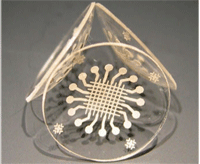
2. Silver wire pressure sensor contact lens to measure IOP.
Yet another team at the University of Western Ontario is using nanoparticles, embedded in hydrogel lenses, to measure an equivalent to blood sugar in the tears.3 The collective research in this area is an indication that one or more of these technologies will be commercialized for non-invasive monitoring for diabetes with smart contact lenses.
Smart Lenses Measuring IOP
Microelectromechanical systems (MEMS) have been developed by STMicroelectronics to measure subtle shape changes of the eye for monitoring intraocular pressure in glaucoma. Sensimed, developed a wireless MEMS sensor that acts as both a transducer and an antenna in a smart contact lens.4 Named “Triggerfish,” the sensor system is an embedded strain gauge in a smart lens, designed to monitor the curvature of the eye.
This device is intended for the management of glaucoma patients—to facilitate diagnosis and treatment that is optimally modulated for each patient. The wirelessly powered lens incorporates the MEMS device, an antenna, a processing circuit and a transmitter to communicate the measurements to a receiver worn by the patient and does not need to be connected to a battery. The components are in the periphery of the lens and do not interfere with vision (see figure 1).
It has been reported that Sensimed anticipates rolling out the product in the U.S. market by the end of 2011.4 In the future, one could envision the IOP monitoring ultimately coupled with drug delivery for the management of glaucoma.
An alternate smart contact lens intended to measure pressure within the eye and dispense medication accordingly could be made possible using a new material developed by biomedical engineers at the University of California, Davis (see figure 2).5 The researchers employ polydimethylsiloxane (PDMS), a material used in the electronics field that holds promise of biocompatibility in contact lenses. They developed a method for metalizing the PDMS with powdered silver in a predetermined pattern to create conductive wires. Silver is also known to be useful in ocular applications for its antimicrobial properties.
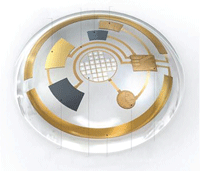
3. Wearable display contact lens with built-in electronics and LED.
The researchers have demonstrated the ability of the silver structure on the PDMS to function as a simple pressure sensor. A continuous measure of IOP could prove useful in the management of glaucoma and may hold promise when coupled with drug delivery.
Drug Delivery Smart Lenses
Soft contact lenses were first reported in 1965 for use in drug delivery in Czechoslovakia; researchers have been working toward creating successful technology for effective treatment of ocular conditions ever since.6 In 1988, research was published that illustrated the potential effectiveness of drug delivery soft lenses compared to subconjunctival drug administration, along with the shortcoming of an initial pulse or peak in delivery followed by a trailing off of drug release.7 The challenge of controlling the rate of delivery over time was defined. The effective dosing of medications is a function of the amount of an eye drop that actually reaches the ocular surface, the speed at which it drains through the puncta or spills over the lids and the compliance of the patient with regard to the frequency and dosage; therefore, a regulated time release by way of a smart contact lens is advantageous.
Eye care practitioners have long understood the shortcoming of eye drops for patients suffering from glaucoma, corneal ulcers and other ocular surface disease. A drug delivery smart lens is also anticipated as useful to control infection during wound healing following trauma and surgery. Several teams of researchers are working on strategies for smart lenses that will release medications more evenly over extended periods.
Funded by the National Institute of General Medicine Sciences, one such smart lens—developed by a team from the Children’s Hospital Boston, the Massachusetts Eye and Ear Infirmary’s ophthalmology department, Schepens Eye Research Institute in Boston and the Massachusetts Institute of Technology’s chemical engineering department—sandwiches pharmaceuticals between two layers of polymer film.8 Their core technology is the suspension of pharmaceutical in a layer of poly-lactic-co-glycolic acid (PLGA), a biodegradable polymer. The relative volume of PLGA to the pharmaceutical regulates the amount that passes through the lens over time. The more PLGA than medication, the slower the drug is released. In lab tests, these multilayer lenses demonstrated their ability to release ciprofloxacin for up to 100 days.8
Two researchers at Singapore’s Institute of Bioengineering and Nanotechnology were granted joint patents for, “Drug-Loaded Contact Lenses for Ocular Drug Delivery,” in Taiwan (2007) and Singapore (2008).9 They have developed a permeable polymer lens that could be laden with eye medication for ocular drug delivery. Researchers at Spain’s University of Santiago de Compostela are also developing acrylic hydrogels with an improved ability to carry drugs and maintain controlled release rate.10
Smart Lenses as Wearable Computers
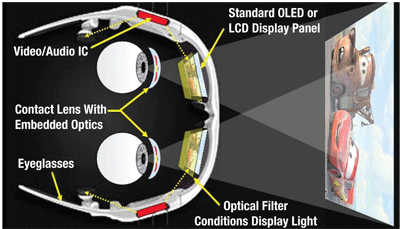
4. Contact lens enabling simultaneous display and real world vision.
Consumers have a big appetite for interactive entertainment and information and, yet, endure small consoles like iPhones and iPads as their visual portals. The iMax theater experience is one evidence in the “bigger is better” enjoyment of media that is appreciated by consumers. It is forecasted that consumers will continue to search for hands-free immersive methods for accessing visual media. The foreseeable end of this search is in wearable information sources. Researchers at the University of Washington are attempting a new generation of wirelessly powered lenses with tiny circuits, light emitting diodes and built-in electronics (see figure 3).11
The team admits the limited function presently but forecasts what is possible with the technology. Even so, team leader Babak Parviz, M.S., Ph.D., is optimistic in saying, “What we’ve done so far barely hints at what will soon be possible with this technology.”12 The researchers intend to turn a lens into a functional system by integrating control circuits, communication circuits and miniature antennas into the lens using custom-built optoelectronic components. While they have only accomplished an 8x8 LED array, the components will eventually include hundreds of LEDs, to form a more rich image on the retina. These components will need to be transparent and have an index of refraction of the lens polymer to avoid the effects of diffraction and refraction within the pupil when the content is not being displayed, or they will need to be miniaturized. Their goal is an array of 3600 10-µm-wide pixels spaced 10 µm apart.12 The content information will be provided to the control circuit of the lenses by portable devices used for regular displays. The team is challenged to make the lens of biocompatible materials and ultimately with passive pixels to reduce the power draw.12
An alternate smart contact lens for wearable interactive entertainment and information is closer to commercialization. The team at Innovega has developed a contact lens with passive optics which when coupled with a spectacle mounted display allows for a full field of view high resolution experience (see figure 4).13 The contact lens has two required components. The first is a center lenslet with a focal length equal to the vertex distance of the eyewear, and the second is a filter to block the display light incident on the contact lens around the lenslet (see figure 5).14 The center lenslet has a diameter of less than 700µ, a fraction of current multifocal contact lenses. As a result, little or no disturbance of the non-display vision is experienced.
At the same time, the resolution of the display is at the full level of the capacity of the user’s eye and the field of view when viewing the display is only limited by the display itself. A 15mm wide microdisplay in the spectacle plane delivers an experience equivalent to a 150 inch television viewed from a 10 foot distance. The amount of content which can be placed on this 15mm display is more than can be viewed on a 19 inch monitor at 20 inches from the eye. The lenses will incorporate a miniature retro-reflector to couple with an eye-tracker in the eyewear. This system will facilitate interactive applications where the eye position can act similarly to a mouse—to give commands and stimulate content changes.14
Rapid development is underway toward transparent displays which facilitate mixed and augmented reality applications where virtual information is viewed simultaneously with real world vision. This utility allows for viewing data without gaze changes, like having your speedometer and gauges in your windshield. Augmented reality is also useful for training and simulation, as well as industrial and telemedicine applications. Information or directions can be rendered to an operator without loss of gaze from the task at hand.
Innovega has been awarded Phase I, Ib and II National Science Foundation SBIR grants and a Phase I Defense Advance Research Projects Agency (DARPA) SBIR Grant.16 Experts in the field of head-mounted displays (HMD) have come to appreciate the value of placing the optics required to focus a display in the spectacle plane in a contact lens to provide a resultant reduction in the bulk of the HMD and an otherwise unlimited field of view.
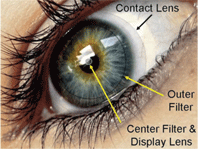
5. Wearable display contact lens with built-in electronics and LED.
Innovega envisions a first adopter use for low vision and defense and an ultimate consumer application for wearable computing. The company is participating with the University of California, San Diego and a host of defense integrators for a larger DARPA program to provide war-fighters with much needed situation awareness for life-saving and mission enhancement. Their need for access to all of the information available is analogous to the consumer appetite for anytime-anywhere access of entertainment and information. The growth in portable computing, mobile gaming and social networking is expected to fuel the demand for this category of smart contact lenses.
Advancements in chemical discovery, nanoparticles, MEMS and miniaturized optical manufacturing have facilitated the development of a wide range of smart contact lenses. These lenses hold promise in health care for the measurement, modulation and treatment of eye and systemic disease, as well as the enhancement of quality of life. Electronic image amplification for low vision, information access for war-fighters and satisfaction of the desire for information and entertainment in a hands-free wearable anytime-anywhere fashion is possible with these new smart lenses. By the year 2020, practitioners may be dispensing far less conventional eyewear and more smart contact lenses.
Dr. Legerton is the co-founder of Innovega, Inc. and co-inventor of the iOptik contact lens enabled wearable display.
Dr. Legerton is an author, lecturer, inventor and consultant to the ophthalmic industry. He was the managing partner of a seven-doctor practice in San Diego for 26 years. He was the cofounder of SynergEyes, and has 25 issued U.S. patents and more than 40 pending applications, including inventions for corneal refractive surgery for presbyopia, Paragon CRT, hybrid contact lenses, regulation of myopia progression, scleral contact lenses, multifocal contact lenses, contact lenses for wearable displays and diagnostic instrumentation for early detection of AMD.
1. Newsome M. High Tech Contact Lenses Monitor Blood Sugar. Healthymagination. 2010 Nov. Available at:
www.healthymagination.com/blog/high-tech-contact-lenses-monitor-blood-sugar (Accessed April 2011).
2. Eng P. Color-Change Lenses Check Blood Sugar. ABC News. 2010 Apr. Available at:
www.abcnews.go.com/Technology/FutureTech/story?id=97664&page=1 (Accessed April 2011).
3. Parkinson J. Contact lenses that measure blood glucose. The Future Well. 2010 Mar. Available at:
www.thefuturewell.com/2010/03/20/contact-lens (Accessed April 2011).
4. Wilson R. Contact lens has MEMS devie to measure glaucoma. Electronics Weekly. 2010 Mar. Available at:
www.electronicsweekly.com/Articles/2010/03/24/48276/contact-lens-has-mems-device-to-measure-glaucoma.htm (Accessed April 2011).
5. Smart Contact Lenses. UC Davis News and Information. 2009 Jul. Available at:
www.news.ucdavis.edu/search/news_detail.lasso?id=8722 (Accessed April 2011).
6. Sedlavek J. Possibilities of application of ophthalmic druss with the aid of gel contact lenses. Cesk Oftalmol. 1965:21;509-14.
7. Jain MR. Drug delivery through soft contact lenses. Br J Ophthalmol. 1988 Feb;72(2):150-4.
8. Ciolino J, Hoare T, Iwata N, et al. A Drug-Eluting Contact Lens. Invest Ophthlamol Vis Sci. 2009 Jul;50(7):3346-52.
9. Drug-loaded contact lenses to treat eye diseases. Institute of Bioengineering and Nanotechnology. 2004 Oct. Available at:
www.ibn.a-star.edu.sg/images/cms_press/press_13.pdf (Accessed April 2011).
10. Zilberman M, Shifrovitch Y, Aviv M and Hershkovitz M. Structured drug-eluting bioresorbable films: microstructure and release profile. J Biomater Appl. 2009 Mar;23(5): 385-406
11. Nusca A. With electronic contact lenses, bionic eyesight could become reality. Smart Planet. 2009 Sep. Available at:
www.smartplanet.com/business/blog/smart-takes/with-electronic-contact-lenses-bionic-eyesight-could-become-reality/566 (Accessed April 2011).
12. Parviz B. Augmented reality in a contact lens. IEEE Spectrum. 2009 Sep. Available at:
www.spectrum.ieee.org/biomedical/bionics/augmented-reality-in-a-contact-lens/0 (Accessed March 2011).
13.Sprague R, Schweigerling J. Full field-of-view augmented reality using contact lenses. The Interservice/Industry Training, Simulation & Education Conference. 2010. Available at:
www.ntsa.metapress.com/app/home/contribution.asp?referrer=parent&backto=issue,68,170;journal,1,18;homemainpublications,1,1; (Accessed April 2011).
14. Innovega. Overview. Available at:
www.innovega-inc.com/page8.html (Accessed April 2011).
15. Personal communication with Randall Sprague. 2011.


